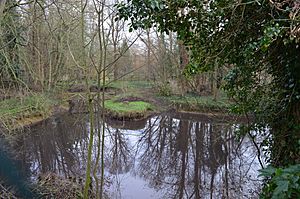Bierton Clay Pit facts for kids
| Site of Special Scientific Interest | |
 |
|
| Area of Search | Buckinghamshire |
|---|---|
| Interest | Geological |
| Area | 0.1 hectares |
| Notification | 1986 |
| Location map | Magic Map |
Bierton Clay Pit is a special place in Bierton, Buckinghamshire. It's a small area, about the size of a football field, that is protected because of its amazing geology. It's known as a Site of Special Scientific Interest (SSSI) and a Geological Conservation Review (GCR) site. This means it's super important for understanding Earth's history!
Contents
What is Bierton Clay Pit?
Bierton Clay Pit used to be a place where people dug out clay from the ground. Now, it's no longer used for digging. This old pit is special because it shows us layers of rock that are millions of years old. These layers help scientists learn about what Earth was like long, long ago.
A Window to the Past
The rocks you can see (or used to see) at Bierton Clay Pit are from the late Jurassic period. This was a very long time ago, between about 157 and 145 million years ago! During this time, dinosaurs roamed the Earth. The specific rock layers here are called the Kimmeridgian and Tithonian stages. They are like pages in a giant history book made of rock.
Uncovering Ancient Sea Beds
This pit is the only place where you can see the northern end of something called the Portland Beds. These are special layers of rock. The pit also shows how these Portland Beds connect with another type of rock layer called the Hartwell Clay. Scientists can study how these layers sit together to understand ancient landscapes.
Clues About Earth's Changes
By looking at these rock layers, geologists found clues about big changes that happened millions of years ago. They saw signs of a time when the land was worn away by wind and water, which is called erosion. After this erosion, the sea level rose, meaning the ocean covered more land than before. This pit helps us understand how our planet has changed over vast amounts of time.
Visiting Bierton Clay Pit
Today, the old clay pit is filled with water, so you can't see the rock layers directly anymore. However, you can still visit the area! There's a footpath between Barnett Way and Brick Kiln Lane where you can view the site. Even though the geology isn't visible, it remains a very important protected area for science.

